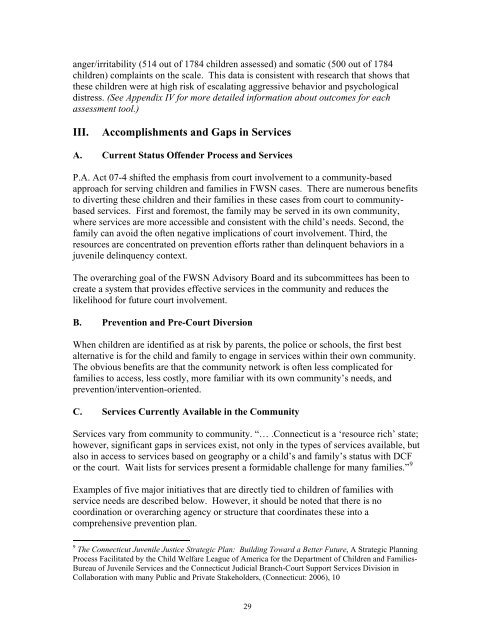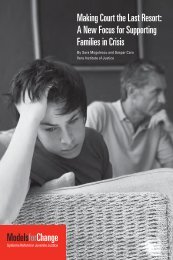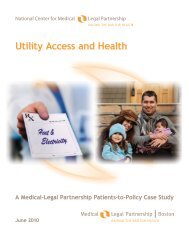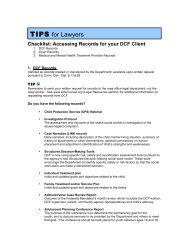FWSN-advisorybd-repo.. - The Connecticut Juvenile Justice Alliance
FWSN-advisorybd-repo.. - The Connecticut Juvenile Justice Alliance
FWSN-advisorybd-repo.. - The Connecticut Juvenile Justice Alliance
You also want an ePaper? Increase the reach of your titles
YUMPU automatically turns print PDFs into web optimized ePapers that Google loves.
anger/irritability (514 out of 1784 children assessed) and somatic (500 out of 1784<br />
children) complaints on the scale. This data is consistent with research that shows that<br />
these children were at high risk of escalating aggressive behavior and psychological<br />
distress. (See Appendix IV for more detailed information about outcomes for each<br />
assessment tool.)<br />
III.<br />
Accomplishments and Gaps in Services<br />
A. Current Status Offender Process and Services<br />
P.A. Act 07-4 shifted the emphasis from court involvement to a community-based<br />
approach for serving children and families in <strong>FWSN</strong> cases. <strong>The</strong>re are numerous benefits<br />
to diverting these children and their families in these cases from court to communitybased<br />
services. First and foremost, the family may be served in its own community,<br />
where services are more accessible and consistent with the child’s needs. Second, the<br />
family can avoid the often negative implications of court involvement. Third, the<br />
resources are concentrated on prevention efforts rather than delinquent behaviors in a<br />
juvenile delinquency context.<br />
<strong>The</strong> overarching goal of the <strong>FWSN</strong> Advisory Board and its subcommittees has been to<br />
create a system that provides effective services in the community and reduces the<br />
likelihood for future court involvement.<br />
B. Prevention and Pre-Court Diversion<br />
When children are identified as at risk by parents, the police or schools, the first best<br />
alternative is for the child and family to engage in services within their own community.<br />
<strong>The</strong> obvious benefits are that the community network is often less complicated for<br />
families to access, less costly, more familiar with its own community’s needs, and<br />
prevention/intervention-oriented.<br />
C. Services Currently Available in the Community<br />
Services vary from community to community. “… .<strong>Connecticut</strong> is a ‘resource rich’ state;<br />
however, significant gaps in services exist, not only in the types of services available, but<br />
also in access to services based on geography or a child’s and family’s status with DCF<br />
or the court. Wait lists for services present a formidable challenge for many families.” 9<br />
Examples of five major initiatives that are directly tied to children of families with<br />
service needs are described below. However, it should be noted that there is no<br />
coordination or overarching agency or structure that coordinates these into a<br />
comprehensive prevention plan.<br />
9 <strong>The</strong> <strong>Connecticut</strong> <strong>Juvenile</strong> <strong>Justice</strong> Strategic Plan: Building Toward a Better Future, A Strategic Planning<br />
Process Facilitated by the Child Welfare League of America for the Department of Children and Families-<br />
Bureau of <strong>Juvenile</strong> Services and the <strong>Connecticut</strong> Judicial Branch-Court Support Services Division in<br />
Collaboration with many Public and Private Stakeholders, (<strong>Connecticut</strong>: 2006), 10<br />
29
















